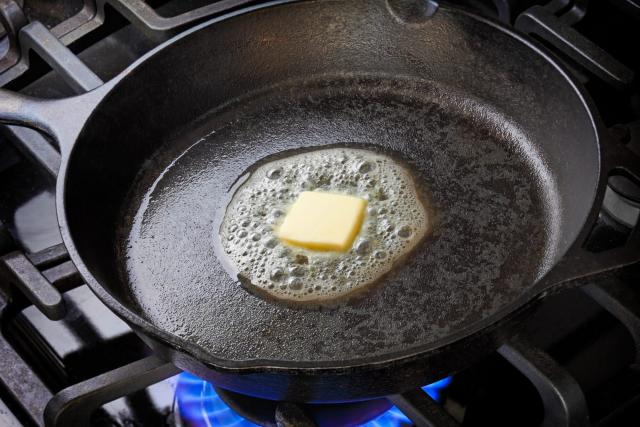(Martha Stewart) Greasing a hot pan is essential to prevent food from sticking: No matter what type of skillet, frying pan, or griddle you use, your cookware needs to be primed well to ensure uncooked ingredients don’t catch or burn, potentially ruining the meal (and filling your kitchen with smoke in the process).
Butter and oil are the two most common types of cooking grease to use at home, but depending on what you’re making, you may want to switch up your go-to pan prep. Here’s how to decide which one to use.
Breakfast Foods
Craving the buttery taste of eggs or curious about how to best prepare your pan for pancakes? You’ll find that these early-day foods can often be made with either butter or oil, say leading chefs.
Scrambled Eggs
Andrew Ayala, the chef de cuisine of Le Jardinier NY, a Bastion Collection restaurant, always recommends butter for cooking eggs. He’s a particular fan of clarified butter for scrambled iterations, which “complements the eggs far better, and adds a nuttier taste and quality.”
“When you clarify butter, you’re removing the milk solids and retaining butterfat, giving a higher smoke point,” Ayala says. “It’s ideal for cooking and sautéing really anything.” You can purchase clarified butter—or make your own ghee to try cooking soft scrambled eggs.
Regular butter works, too; use an unsalted variety, so you can season your own eggs. Prepare the pan by melting the butter at a low heat, and then adding eggs at the same temperature, slowly cooking until you reach your desired consistency.
Fried Eggs
Chef Ashley Abodeely, of the NoMad London, is a fan of frying eggs in butter, too. “When they are fried, it gives them a little toasted brown butter flavor, which only adds to the eggs,” she says. “Butter also makes everything better!”
Butter certainly works for fried eggs, but oil is the fat of choice for cooks who want a runny yolk with a satisfying crispy white. Extra-virgin olive oil is most popular, and yields a satisfyingly crunchy bottom that will soak up luscious flavor. To use olive oil to fry an egg, heat it in a shallow pan and crack eggs directly into the oil once it starts to heat and slightly bubble. You can also baste the egg whites in hot oil for a bubbly, crackly exterior. Once the egg is set, remove it from the hot oil with a fish spatula so the excess fat drains.
Vegetable oil or oils that have a high smoke point, like peanut, grapeseed, and avocado oil, can also be used to cook sunnyside up and over easy eggs.
Pancakes
There’s no one right answer for pancakes: Some chefs are fans of using butter, while others swear by greasing their pan or griddle with oil. If you go with the former, a high-fat butter, sold in a stick (not whipped!), works best for this breakfast food.
There is, however, a downside to using butter: While Abdoleey uses this ingredient in her pancakes—which she says “gives the pancakes delicious flavor and fluffy texture when cooked—she warns home cooks to take caution. When flipping pancakes in standard butter, they may “brown too fast and burn before the pancake is cooked all the way through,” she says.
Should this be your problem, try experimenting with the size of your pancake and the level of heat—or switch to oil. “A little grapeseed oil gets it nice and crispy,” she says. “This also allows the pancakes to get an even color and cook all the way through without burning.” The key is to use an oil with a neutral flavor, like vegetable oil, and use it sparingly, so the pancakes maintain a nice texture and aren’t too hard on either side.






